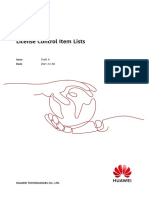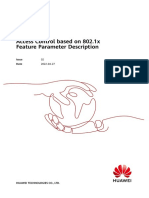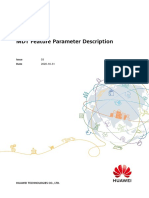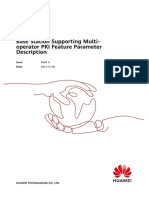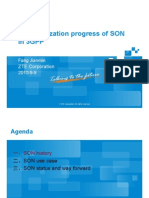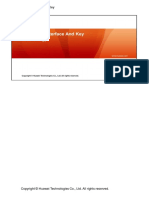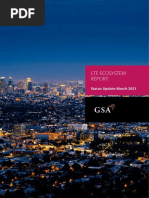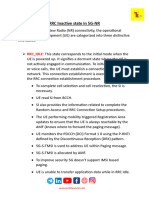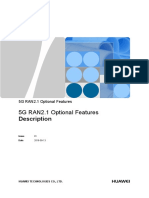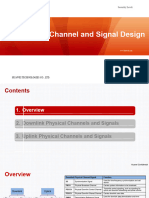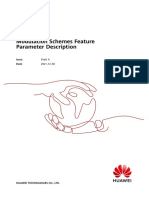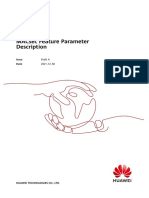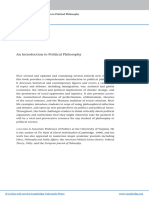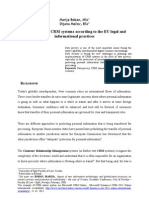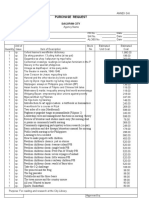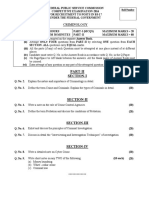Ecpri (Sran18.1 Draft A)
Ecpri (Sran18.1 Draft A)
Uploaded by
VVLCopyright:
Available Formats
Ecpri (Sran18.1 Draft A)
Ecpri (Sran18.1 Draft A)
Uploaded by
VVLOriginal Title
Copyright
Available Formats
Share this document
Did you find this document useful?
Is this content inappropriate?
Copyright:
Available Formats
Ecpri (Sran18.1 Draft A)
Ecpri (Sran18.1 Draft A)
Uploaded by
VVLCopyright:
Available Formats
SingleRAN
eCPRI Feature Parameter
Description
Issue Draft A
Date 2021-12-30
HUAWEI TECHNOLOGIES CO., LTD.
Copyright © Huawei Technologies Co., Ltd. 2022. All rights reserved.
No part of this document may be reproduced or transmitted in any form or by any means without prior
written consent of Huawei Technologies Co., Ltd.
Trademarks and Permissions
and other Huawei trademarks are trademarks of Huawei Technologies Co., Ltd.
All other trademarks and trade names mentioned in this document are the property of their respective
holders.
Notice
The purchased products, services and features are stipulated by the contract made between Huawei and
the customer. All or part of the products, services and features described in this document may not be
within the purchase scope or the usage scope. Unless otherwise specified in the contract, all statements,
information, and recommendations in this document are provided "AS IS" without warranties, guarantees
or representations of any kind, either express or implied.
The information in this document is subject to change without notice. Every effort has been made in the
preparation of this document to ensure accuracy of the contents, but all statements, information, and
recommendations in this document do not constitute a warranty of any kind, express or implied.
Huawei Technologies Co., Ltd.
Address: Huawei Industrial Base
Bantian, Longgang
Shenzhen 518129
People's Republic of China
Website: https://www.huawei.com
Email: support@huawei.com
Issue Draft A Copyright © Huawei Technologies Co., Ltd. i
(2021-12-30)
SingleRAN
eCPRI Feature Parameter Description Contents
Contents
1 Change History.........................................................................................................................1
1.1 SRAN18.1 Draft A (2021-12-30)........................................................................................................................................ 1
2 About This Document.............................................................................................................3
2.1 General Statements................................................................................................................................................................ 3
2.2 Applicable RAT......................................................................................................................................................................... 3
2.3 Differences................................................................................................................................................................................. 4
3 eCPRI...........................................................................................................................................5
3.1 Principles.................................................................................................................................................................................... 5
3.1.1 Overview................................................................................................................................................................................. 5
3.1.2 Line Rate Requirements in Typical Cell Configurations.......................................................................................... 5
3.1.3 Bandwidth-based Admission Control for Cell Setup................................................................................................7
3.1.4 eCPRI MUX............................................................................................................................................................................. 9
3.1.4.1 Co-MPT Scenarios............................................................................................................................................................ 9
3.1.4.2 Separate-MPT Scenarios.............................................................................................................................................. 12
3.1.4.3 Bandwidth Specifications of LTE and NR Fiber Sharing Cells......................................................................... 13
3.1.5 eCPRI Sharing..................................................................................................................................................................... 14
3.1.6 Security................................................................................................................................................................................. 17
3.1.7 Clock Synchronization...................................................................................................................................................... 18
3.2 Network Analysis.................................................................................................................................................................. 19
3.2.1 Benefits................................................................................................................................................................................. 20
3.2.2 Impacts.................................................................................................................................................................................. 20
3.3 Requirements......................................................................................................................................................................... 21
3.3.1 Licenses................................................................................................................................................................................. 21
3.3.2 Software................................................................................................................................................................................21
3.3.3 Hardware.............................................................................................................................................................................. 21
3.3.4 Others.................................................................................................................................................................................... 22
3.4 Operation and Maintenance............................................................................................................................................. 22
3.4.1 Data Configuration........................................................................................................................................................... 22
3.4.1.1 Data Preparation............................................................................................................................................................ 22
3.4.1.2 Using MML Commands............................................................................................................................................... 24
3.4.1.3 Using the MAE-Deployment...................................................................................................................................... 24
3.4.2 Activation Verification..................................................................................................................................................... 24
Issue Draft A Copyright © Huawei Technologies Co., Ltd. ii
(2021-12-30)
SingleRAN
eCPRI Feature Parameter Description Contents
3.4.3 Network Monitoring......................................................................................................................................................... 26
4 Glossary................................................................................................................................... 28
5 Reference Documents...........................................................................................................29
Issue Draft A Copyright © Huawei Technologies Co., Ltd. iii
(2021-12-30)
SingleRAN
eCPRI Feature Parameter Description 1 Change History
1 Change History
This chapter describes changes not included in the "Parameters", "Counters",
"Glossary", and "Reference Documents" chapters. These changes include:
● Technical changes
Changes in functions and their corresponding parameters
● Editorial changes
Improvements or revisions to the documentation
1.1 SRAN18.1 Draft A (2021-12-30)
This issue introduces the following changes to SRAN17.1 05 (2021-09-29).
Technical Changes
Change Description Parameter Change Base Station
Model
Added support for eCPRI BER None 3900 and 5900
monitoring on the MAE. For series base stations
details, see eCPRI BER
Monitoring.
Modified requirements for the None 3900 and 5900
line rate over an eCPRI interface series base stations
and bandwidth-based admission
control for cell setup in high-
frequency scenarios. For details,
see 3.1.2 Line Rate
Requirements in Typical Cell
Configurations and 3.1.3
Bandwidth-based Admission
Control for Cell Setup.
Issue Draft A Copyright © Huawei Technologies Co., Ltd. 1
(2021-12-30)
SingleRAN
eCPRI Feature Parameter Description 1 Change History
Editorial Changes
Revised descriptions in this document.
Updated some figures.
Issue Draft A Copyright © Huawei Technologies Co., Ltd. 2
(2021-12-30)
SingleRAN
eCPRI Feature Parameter Description 2 About This Document
2 About This Document
2.1 General Statements
Purpose
Feature Parameter Description documents are intended to acquaint readers with:
● The technical principles of features and their related parameters
● The scenarios where these features are used, the benefits they provide, and
the impact they have on networks and functions
● Requirements of the operating environment that must be met before feature
activation
● Parameter configuration required for feature activation, verification of feature
activation, and monitoring of feature performance
NOTE
This document only provides guidance for feature activation. Feature deployment and
feature gains depend on the specifics of the network scenario where the feature is
deployed. To achieve optimal gains, contact Huawei professional service engineers.
Software Interfaces
Any parameters, alarms, counters, or managed objects (MOs) described in Feature
Parameter Description documents apply only to the corresponding software
release. For future software releases, refer to the corresponding updated product
documentation.
2.2 Applicable RAT
This document applies to LTE TDD and NR.
Issue Draft A Copyright © Huawei Technologies Co., Ltd. 3
(2021-12-30)
SingleRAN
eCPRI Feature Parameter Description 2 About This Document
2.3 Differences
Table 2-1 Differences between NSA and SA
Function Name Difference Chapter/Section
eCPRI None 3 eCPRI
Table 2-2 Differences between high frequency bands and low frequency bands
Function Name Difference Chapter/Section
eCPRI None 3 eCPRI
This document refers to frequency bands belonging to FR1 (410–7125 MHz) as
low frequency bands, and those belonging to FR2 (24250–52600 MHz) as high
frequency bands. For details about FR1 and FR2, see section 5.1 "General" in 3GPP
TS 38.104 V15.5.0.
Issue Draft A Copyright © Huawei Technologies Co., Ltd. 4
(2021-12-30)
SingleRAN
eCPRI Feature Parameter Description 3 eCPRI
3 eCPRI
3.1 Principles
3.1.1 Overview
The Enhanced Common Public Radio Interface (eCPRI) protocol is used for the
connection between a baseband unit (BBU) and an active antenna unit (AAU) in a
radio base station. After a BBU is connected to an AAU through their CPRI ports, a
link between them is then set up to transmit control-plane, user-plane, and clock
data. In the following sections, an eCPRI interface or port refers to a CPRI interface
or port using the eCPRI protocol.
eCPRI differs from CPRI in the following aspects:
● eCPRI enables functional split at the physical layer. Specifically, certain
processing units at the physical layer are relocated from the BBU to the AAU.
For details, see sections 2.3 "Functional Decomposition" and 6.1.1 "eCPRI
Functional Decomposition" in eCPRI Specification V1.1.
● eCPRI uses the Ethernet for data transmission, whereas CPRI uses the time
division multiplexing (TDM) for data transmission. For details, see section
3.2.1 "User Plane over Ethernet" in eCPRI Specification V1.1.
Topology
For details about the topologies supported by the eCPRI protocol, see RF Unit and
Topology Management.
3.1.2 Line Rate Requirements in Typical Cell Configurations
Requirements for the line rate over an eCPRI interface are affected by the cell
bandwidth, number of antennas, numbers of uplink and downlink layers, and
other factors. Table 3-1, Table 3-2, and Table 3-3 list requirements for the line
rate over an eCPRI interface in typical cell configurations.
Issue Draft A Copyright © Huawei Technologies Co., Ltd. 5
(2021-12-30)
SingleRAN
eCPRI Feature Parameter Description 3 eCPRI
Table 3-1 Requirements for the line rate over an eCPRI interface in typical NR
TDD (low frequency) cell configurations
Number of Antennas 64T64R 32T32R
Number of Uplink and 16 in the downlink 16 in the downlink
Downlink Layers 8 in the uplink 8 in the uplink
100 MHz 25 Gbit/s 25 Gbit/s
90 MHz 22.5 Gbit/s 22.5 Gbit/s
80 MHz 20 Gbit/s 20 Gbit/s
70 MHz 17.5 Gbit/s 17.5 Gbit/s
60 MHz 15 Gbit/s 15 Gbit/s
50 MHz 12.5 Gbit/s 12.5 Gbit/s
40 MHz 10 Gbit/s 10 Gbit/s
30 MHz 7.5 Gbit/s 7.5 Gbit/s
20 MHz 5 Gbit/s 5 Gbit/s
Table 3-2 Requirements for the line rate over an eCPRI interface in NR TDD (high
frequency) cell configurations
Number of Antennas 4T4R 8T8R
200 MHz 6.25 Gbit/s 12.5 Gbit/s
100 MHz 3.125 Gbit/s 6.25 Gbit/s
Table 3-3 Requirements for the line rate over an eCPRI interface in typical LTE
TDD cell configurations
Number of Antennas 64T64R 32T32R
Number of Uplink and 16 in the downlink 16 in the downlink
Downlink Layers 8 in the uplink 8 in the uplink
20 MHz 5 Gbit/s 5 Gbit/s
15 MHz 3.75 Gbit/s 3.75 Gbit/s
10 MHz 2.5 Gbit/s 2.5 Gbit/s
Issue Draft A Copyright © Huawei Technologies Co., Ltd. 6
(2021-12-30)
SingleRAN
eCPRI Feature Parameter Description 3 eCPRI
NOTE
● The one-way transmission delay over an eCPRI interface between a BBU and an AAU
must be less than or equal to 100 μs. The maximum distance between a BBU and an
AAU is 20 km when no transmission equipment is used between them. The maximum
distance is less than 20 km when transmission equipment is used between them. This is
because extra delay is generated due to the usage of transmission equipment. If the
distance exceeds 20 km, the cell capabilities, such as uplink and downlink throughput
and access success rate decrease.
● In the current version, LTE TDD and NR TDD (low frequency) support 10 Gbit/s and 25
Gbit/s optical modules as well as optical fiber connections of 1x10 Gbit/s, 1x25 Gbit/s,
2x10 Gbit/s, and 2x25 Gbit/s. They do not support the optical fiber connection of 1x10
Gbit/s+1x25 Gbit/s. NR TDD (high frequency) supports 25 Gbit/s optical modules as well
as optical fiber connections of 1x25 Gbit/s and 2x25 Gbit/s. When the eCPRI interface
configuration is less than the interface bandwidth requirement, cell setup may fail, or
the numbers of uplink and downlink layers or the traffic specifications in the cell may
be limited.
● According to LTE TDD bandwidth requirements, a single 25 Gbit/s optical fiber can bear
a maximum data volume of five 20 MHz 64T64R cells. If cell setup fails, check the
number of carriers on the optical fibers first.
1. Run the LST RRUCHAIN command to view the number of optical fibers.
2. Run the DSP CELLPHYTOPO command to query the carrier configuration of an AAU.
Ensure that the number of carriers is less than or equal to five times the number of
optical fibers.
3.1.3 Bandwidth-based Admission Control for Cell Setup
When multiple cells served by an AAU share optical fibers, the optical fiber
bandwidth may not meet the cell bandwidth requirements. The cells can be
multiple NR cells, LTE cells, or NR and LTE cells sharing an AAU. Provided that
peak bandwidth of multiple cells is non-concurrent, admission control is
performed based on the bandwidth lower than the peak bandwidth during cell
setup. Table 3-4 describes the admission policies for NR TDD. Table 3-5 describes
the admission policies for LTE TDD.
For LTE TDD cells, the eCPRI compression function can be enabled to reduce the
single-carrier admission bandwidth, increasing the number of carriers supported
on an eCPRI optical fiber and lowering the optical fiber deployment cost. The
eCPRI compression function takes effect when the Cell.CPRICompression
parameter is set to ECPRI_COMPRESSION. This function applies only to massive
MIMO cells. Table 3-6 describes the admission policies for LTE TDD cells after the
function takes effect.
During cell setup, the base station applies for bandwidth based on the guaranteed
bandwidth. If the bandwidth application fails, the cell setup fails. If the actual data
transmission requirements of cells are higher than the actual transmission
bandwidth of optical fibers, the numbers of uplink and downlink layers or traffic
specifications of cells are limited.
Issue Draft A Copyright © Huawei Technologies Co., Ltd. 7
(2021-12-30)
SingleRAN
eCPRI Feature Parameter Description 3 eCPRI
Table 3-4 Peak bandwidth and guaranteed bandwidth of NR TDD cells
Cell Type UL/DL Peak UL/DL Guaranteed
Bandwidth (Gbit/s) Bandwidth (Gbit/s)
Low-frequency 100 MHz 25 5
64T64R/32T32R
Low-frequency 90 MHz 22.5 5
64T64R/32T32R
Low-frequency 80 MHz 20 5
64T64R/32T32R
Low-frequency 70 MHz 17.5 5
64T64R/32T32R
Low-frequency 60 MHz 15 5
64T64R/32T32R
Low-frequency 50 MHz 12.5 5
64T64R/32T32R
Low-frequency 40 MHz 10 5
64T64R/32T32R
Low-frequency 30 MHz 7.5 5
64T64R/32T32R
Low-frequency 20 MHz 5 5
64T64R/32T32R
High-frequency 200 MHz 8T8R 12.5 12.5
High-frequency 200 MHz 4T4R 6.25 6.25
High-frequency 200 MHz 4T4R 12.5 12.5
High-frequency 100 MHz 8T8R 6.25 6.25
High-frequency 100 MHz 4T4R 3.125 3.125
Table 3-5 Peak bandwidth and guaranteed bandwidth of LTE TDD cells
Cell Type UL/DL Peak UL/DL Guaranteed
Bandwidth (Gbit/s) Bandwidth (Gbit/s)
20 MHz 64T64R/32T32R 5 5
15 MHz 64T64R/32T32R 3.75 3.75
10 MHz 64T64R/32T32R 2.5 2.5
Issue Draft A Copyright © Huawei Technologies Co., Ltd. 8
(2021-12-30)
SingleRAN
eCPRI Feature Parameter Description 3 eCPRI
Table 3-6 Peak bandwidth and guaranteed bandwidth of LTE TDD cells after the
eCPRI compression function takes effect
Cell Type UL/DL Peak UL/DL Guaranteed
Bandwidth (Gbit/s) Bandwidth (Gbit/s)
20 MHz 64T64R/32T32R 5 3
15 MHz 64T64R/32T32R 3.75 2.25
10 MHz 64T64R/32T32R 2.5 1.5
3.1.4 eCPRI MUX
eCPRI Multiplex (eCPRI MUX) enables multiple modes in a multimode base station
to use the same eCPRI port for data transmission. eCPRI MUX can only be used
within one BBU.
eCPRI MUX is implemented by converging data of multiple modes. Figure 3-1
shows the eCPRI MUX principles. The board of network mode B is connected to
the board of network mode A through the backplane. In this way, data of network
mode B is converged on the board of network mode A. Then, the board of
network mode A is connected to a multimode AAU through an optical fiber which
carries data of both network modes A and B.
The board of network mode A serves as the converging board and network mode
A is the converging party. The board of network mode B serves as the converged
board and network mode B is the converged party.
Figure 3-1 eCPRI MUX principles when data of multiple network modes is
converged
3.1.4.1 Co-MPT Scenarios
LTE and NR Co-MPT
In LTE and NR co-MPT scenarios, when the total transmission bandwidth required
by the LTE and NR cells served by an AAU is less than the transmission bandwidth
Issue Draft A Copyright © Huawei Technologies Co., Ltd. 9
(2021-12-30)
SingleRAN
eCPRI Feature Parameter Description 3 eCPRI
of the optical fiber connecting to the AAU, eCPRI MUX can be used. The AAU can
be connected to an LTE baseband processing unit or an NR baseband processing
unit through one optical fiber. A single-fiber eCPRI link is set up between the BBU
and AAU through the baseband processing unit. Control-plane, user-plane, and
clock data are transmitted over the single-fiber eCPRI link, as shown in Figure 3-2.
Figure 3-2 Single-fiber eCPRI MUX in a co-MPT scenario (using the BBU5900 as
an example)
A load sharing topology is used when the physical bandwidth of an eCPRI link is
insufficient to support a cell. In a load sharing topology, a BBU is connected to an
AAU through two interfaces. This ensures that the physical bandwidth of the two
interfaces can meet the cell bandwidth requirements. Two eCPRI links are set up
between the BBU and AAU. User-plane and clock data is transmitted on both links.
Control-plane data is transmitted on either of the links. Load sharing can be
classified into intra-board load sharing and inter-board load sharing, as shown in
Figure 3-3.
Issue Draft A Copyright © Huawei Technologies Co., Ltd. 10
(2021-12-30)
SingleRAN
eCPRI Feature Parameter Description 3 eCPRI
Figure 3-3 eCPRI MUX with a load sharing topology in a co-MPT scenario (using
the BBU5900 as an example)
● Intra-board load sharing (recommended)
– When the bandwidth of one eCPRI link is sufficient to support all services,
the other eCPRI link provides redundancy backup.
– When the eCPRI link that carries operations and maintenance (O&M)
services is faulty, the O&M services are automatically switched over to
the other eCPRI link.
Issue Draft A Copyright © Huawei Technologies Co., Ltd. 11
(2021-12-30)
SingleRAN
eCPRI Feature Parameter Description 3 eCPRI
– If one eCPRI link is faulty and the bandwidth of the other eCPRI link is
insufficient to support all cells, some cells may become unavailable.
● Inter-board load sharing
– When the eCPRI link that carries O&M services is faulty, the O&M services
are automatically switched over to the other eCPRI link.
– When one eCPRI link is faulty, the cells carried on the eCPRI link are
unavailable.
– In the multimode inter-board load sharing topology, two ports on an AAU
must connect to two baseband processing units in different modes.
NOTE
● It is not recommended that two boards in the same mode be used for inter-board load
sharing. In this scenario, cells must be deployed on boards that directly connect to the
AAU through optical fibers.
● When the O&M services carried on a faulty eCPRI link are automatically switched over
to the other eCPRI link, the service data during a short time is lost.
3.1.4.2 Separate-MPT Scenarios
LTE and NR Separate-MPT
In LTE and NR separate-MPT scenarios, when the total transmission bandwidth
required by the LTE and NR cells served by an AAU is less than the transmission
bandwidth of the optical fiber connecting to the AAU, eCPRI MUX can be used.
The AAU can be connected to an LTE baseband processing unit or an NR baseband
processing unit through the optical fiber, as shown in Figure 3-4.
Issue Draft A Copyright © Huawei Technologies Co., Ltd. 12
(2021-12-30)
SingleRAN
eCPRI Feature Parameter Description 3 eCPRI
Figure 3-4 eCPRI MUX in a separate-MPT scenario (using the BBU5900 as an
example)
The constraints on eCPRI MUX in separate-MPT scenarios are listed as follows:
● The converging party cannot serve as the converged party.
● The AAU and the corresponding chain/ring on the converging party must be
configured prior to those on the converged party. If the AAU and the
corresponding chain/ring on the converging party is not configured, services
of the converged party are unavailable.
● Each BBU supports three pairs of one-to-one convergence relationships, that
is, a maximum of 18 ports can be provided for data convergence.
● CPRI MUX and eCPRI MUX cannot be supported simultaneously by a group of
converging and converged boards.
● In intra-mode inter-BBU deployment scenarios, eCPRI MUX is not supported
by the leaf BBU.
● For AAUs of versions earlier than SRAN16.1, the software loading control
rights need to be granted to the converging party during the upgrade to
SRAN16.1.
3.1.4.3 Bandwidth Specifications of LTE and NR Fiber Sharing Cells
In eCPRI MUX scenarios, the maximum bandwidth specifications of LTE and NR
fiber sharing cells are dependent on the number of antennas, numbers of uplink
and downlink layers, and line rate, as listed in Table 3-7.
Issue Draft A Copyright © Huawei Technologies Co., Ltd. 13
(2021-12-30)
SingleRAN
eCPRI Feature Parameter Description 3 eCPRI
Table 3-7 Maximum bandwidth specifications of LTE and NR fiber sharing cells
Number of Number of 25 Gbit/s 2x25 Gbit/s
Antennas Uplink and
Downlink
Layers
64T64R 16 in the NR X MHz+ LTE Y NR 100 MHz+LTE
downlink MHza 5x20 MHz
8 in the
uplink
32T32R 16 in the NR X MHz+ LTE Y NR 100 MHz+LTE
downlink MHza 5x20 MHz
8 in the
uplink
a: X + Y ≤ 100
3.1.5 eCPRI Sharing
For a single-mode base station, the eCPRI sharing mode can be used to save
optical fibers between the BBU and AAU(s). The baseband processing unit that
processes services does not directly connect to the AAU through an optical fiber.
Instead, it shares the optical fiber connecting to the AAU with another baseband
processing unit that provides the interface. The two baseband processing units are
interconnected through the backplane of the BBU subrack, as shown in Figure
3-5.
Issue Draft A Copyright © Huawei Technologies Co., Ltd. 14
(2021-12-30)
SingleRAN
eCPRI Feature Parameter Description 3 eCPRI
Figure 3-5 eCPRI sharing (using the BBU5900 as an example)
The backplane bandwidth between the baseband processing unit that provides the
interface and the baseband processing unit that processes services is as follows:
● If both the baseband processing units are full-width boards, the backplane
bandwidth is 2x50 Gbit/s.
● If both the baseband processing units are half-width boards, the backplane
bandwidth is 100 Gbit/s.
● If one is a full-width board and the other is a half-width board, the backplane
bandwidth is 50 Gbit/s.
NOTE
● In eCPRI sharing mode, when the baseband processing unit that provides the interface is
faulty, the cells on the baseband processing unit that processes services will be out of
service and related alarms are generated.
● The eCPRI and other coordination-based features share the backplane bandwidth.
In eCPRI sharing mode, the baseband processing unit that provides the interface
can be connected to the AAU(s) in the star or load sharing topology. Intra-board
load sharing is recommended if the load sharing topology is used. If the inter-
board load sharing topology is used, cells must be deployed on boards that
directly connect to the AAU through optical fibers, as shown in Figure 3-6 and
Figure 3-7.
Issue Draft A Copyright © Huawei Technologies Co., Ltd. 15
(2021-12-30)
SingleRAN
eCPRI Feature Parameter Description 3 eCPRI
Figure 3-6 eCPRI sharing in a star topology (using the BBU5900 as an example)
Issue Draft A Copyright © Huawei Technologies Co., Ltd. 16
(2021-12-30)
SingleRAN
eCPRI Feature Parameter Description 3 eCPRI
Figure 3-7 eCPRI sharing in a load sharing topology (using the BBU5900 as an
example)
3.1.6 Security
The eCPRI interface transmits data over the Ethernet, which increases the risk of
information leakage, tampering, and flood attacks. The following security
measures are supported in base stations to ensure eCPRI interface security:
● TLS authentication, encryption, and integrity protection
These functions are enabled by default and used for the control plane
between the BBU and AAU.
TLS authentication uses digital certificates. Asymmetric keys are used to
authenticate equipment identities during digital certificate authentication.
Specifically, the sender uses a private key to sign data, and the receiver uses a
public key in the certificate to verify signature validity. With digital certificates,
both the receiver and the sender confirm each other's identities to protect
against communication fraud and eavesdropping. For details, see SSL and PKI.
If TLS authentication fails on the eCPRI interface, ALM-26235 RF Unit
Maintenance Link Failure is reported.
Issue Draft A Copyright © Huawei Technologies Co., Ltd. 17
(2021-12-30)
SingleRAN
eCPRI Feature Parameter Description 3 eCPRI
NOTE
● Boards with eCPRI ports, including baseband processing units and RF modules, are
preconfigured with a Huawei-issued device certificate before delivery. The
certificate can be replaced with an operator certificate.
● If the Huawei-issued device certificate of an AAU is damaged, you can run the SET
RRUSECPOLICY command on the BBU to change the authentication mode to
NONE(Verify None). You can also run the DSP RRUTLSERRINFO command to
query the actual negotiated authentication mode.
● PDCP encryption over the air interface
This function prevents the user-plane data between the BBU and AAU from
being illegally intercepted or disclosed. For details, see Radio Security.
● Anti-flooding function
This function is enabled by default. Currently, it is supported only on BBU
eCPRI interfaces. The detection of common protocols (such as TCP/UDP/ARP)
is supported. If the number of detected packets exceeds a specified threshold,
ALM-25950 Base Station Being Attacked is reported.
3.1.7 Clock Synchronization
When the BBU and AAU are connected through the eCPRI interface, a base station
provides IEEE 1588V2+SyncE clock signals for the AAU. SyncE refers to
synchronous Ethernet. The IEEE 1588V2 clock and SyncE clock share the same
source, and the two types of clocks implement time synchronization and
frequency synchronization, respectively. The introduction of the SyncE clock can
improve the frequency synchronization precision of the AAU to meet precision
requirements.
The BBU is configured as the IEEE 1588V2+SyncE master, and the AAU is used as
the IEEE 1588V2+SyncE slave to implement synchronization with the BBU. The
configuration does not require any extra license. The AAU can work in ordinary
clock (OC) mode only, as shown in Figure 3-8.
Issue Draft A Copyright © Huawei Technologies Co., Ltd. 18
(2021-12-30)
SingleRAN
eCPRI Feature Parameter Description 3 eCPRI
Figure 3-8 Example of IEEE 1588V2 and SyncE combination
Clock Requirements
The AAU obtains synchronous clock signals from the BBU through the eCPRI
interface. In addition, it obtains only the 1588V2+SyncE clock signals.
The requirements for eCPRI fronthaul clock synchronization specifications are as
follows:
● For time synchronization accuracy requirements, see section 4.2 "Timing
accuracy requirements" in eCPRI Transport Network V1.2.
● For frequency synchronization accuracy requirements, see section 6.4.2
"Frequency synchronization requirements" in 802.1CM-2018 - IEEE Standard
for Local and metropolitan area networks -- Time-Sensitive Networking for
Fronthaul.
Impact of the Clock Mutual Lock Switchover
The impact of BBU clock mutual lock switchover in the eCPRI scenario is the same
as that in the CPRI scenario. For details, see "Inter-RAT Clock Lock" in Common
Clock.
3.2 Network Analysis
Issue Draft A Copyright © Huawei Technologies Co., Ltd. 19
(2021-12-30)
SingleRAN
eCPRI Feature Parameter Description 3 eCPRI
3.2.1 Benefits
This feature enables the reduction of the transmission bandwidth between the
BBU and AAU as well as the transmission resources required by massive MIMO
and other large-bandwidth multi-antenna services. This further saves costs.
3.2.2 Impacts
Network Impacts
● eCPRI MUX in separate-MPT scenarios
– Operations or exceptions of the converging party
Data and voice services of the converged party will be interrupted if any
of the following occurs on the converging party. The interruptions last
less than 3 minutes in most cases and will not exceed 3.5 minutes.
▪ A software reset is performed on the converging board or the main
control board, the converging board or the main control board is
reset through a power cycle, or the converging board or the main
control board is removed and then reinserted.
▪ The converging board is blocked.
▪ Commissioning is performed on a CPRI port of the converging board.
▪ A CPRI port of the converging board becomes faulty.
– Operations or exceptions of the converged party
▪ If a software reset is performed on the main control board of the
converged party, the rate of data services of the converging party
may decrease. The impact lasts for less than 3s in most cases and
does not last for over 10s. However, voice services will not be
affected.
▪ If the main control board of the converged party is reset through a
power cycle or removed and then inserted, data and voice services of
the converging party will be interrupted for less than 1 minute in
most cases. In the worst case, the service interruption does not last
for over 3 minutes.
● eCPRI MUX in co-MPT scenarios
Data and voice services of the converged party will be interrupted if any of
the following occurs on the converging party. Most interruptions last less than
3 minutes and the longest does not exceed 3.5 minutes.
– A software reset is performed on the converging board, the converging
board is reset through a power cycle, the converging board is blocked, or
the converging board is removed and then reinserted.
– Commissioning is performed on a CPRI port of the converging board.
– A CPRI port of the converging board becomes faulty.
● eCPRI sharing scenarios
Data and voice services of the converged party will be interrupted if any of
the following occurs on the baseband processing unit that provides the
Issue Draft A Copyright © Huawei Technologies Co., Ltd. 20
(2021-12-30)
SingleRAN
eCPRI Feature Parameter Description 3 eCPRI
interface. The interruptions last less than 3 minutes in most cases and will not
exceed 3.5 minutes.
– A software reset is performed on the converging board, the converging
board is reset through a power cycle, the converging board is blocked, or
the converging board is removed and then reinserted.
– Commissioning is performed on a CPRI port of the converging board.
– A CPRI port of the converging board becomes faulty.
NOTE
Service interruption duration does not include the duration of manual operations, such as
blocking a board or removing and then inserting a board.
Function Impacts
None
3.3 Requirements
3.3.1 Licenses
None
3.3.2 Software
Before activating this function, ensure that its prerequisite functions have been
activated and mutually exclusive functions have been deactivated. For detailed
operations, see the relevant feature documents.
Prerequisite Functions
RAT Function Name Function Switch Reference
NR Network None Synchronization
Synchronization
LTE TDD Enhanced None Synchronization in
Synchronization eRAN Feature
Documentation
Mutually Exclusive Functions
None
3.3.3 Hardware
Base Station Models
3900 and 5900 series base stations. 3900 series base stations must be configured
with the BBU3910.
Issue Draft A Copyright © Huawei Technologies Co., Ltd. 21
(2021-12-30)
SingleRAN
eCPRI Feature Parameter Description 3 eCPRI
Boards
Board RAT
UMPTe series LTE and NR
UMPTg series LTE and NR
UMPTga series LTE and NR
UBBPf3 LTE
UBBPfw1a LTE and NR
UBBPg3b LTE and NR
UBBPg2a LTE and NR
UBBPg3 LTE and NR
a: The UBBPfw1 does not support the eCPRI compression function for LTE TDD
cells.
RF Modules
Only AAUs support this function. For details about AAU models that support the
eCPRI protocol, see CPRI port specifications in the AAU technical specifications in
3900 & 5900 Series Base Station Product Documentation.
Cells
To enable the eCPRI compression function for an LTE TDD cell:
● The Cell.FddTddInd parameter must be set to CELL_TDD.
● When the Cell.CellActiveState parameter is set to CELL_ACTIVE, the eCPRI
compression function must be enabled for all cells served by the AAU serving
the cell. The cell needs to be reactivated when the eCPRI compression
function is enabled or disabled.
3.3.4 Others
None
3.4 Operation and Maintenance
3.4.1 Data Configuration
3.4.1.1 Data Preparation
By default, the security and clock synchronization functions for the eCPRI interface
are enabled and do not need to be manually configured.
Issue Draft A Copyright © Huawei Technologies Co., Ltd. 22
(2021-12-30)
SingleRAN
eCPRI Feature Parameter Description 3 eCPRI
For eCPRI topologies (including eCPRI MUX and eCPRI sharing), the parameters in
the RRUCHAIN and RRU MOs need to be set for the eCPRI interface. For detailed
configurations, see section "Operation and Maintenance" for a specific base
station model in RF Unit and Topology Management. For eCPRI MUX in separate-
MPT scenarios:
● The AAU and corresponding chain/ring configurations of the converged party
take effect only after those of the converging party have been configured.
● There are no special requirements on the configurations of the converging
party. For detailed configurations, see section "Operation and Maintenance"
for a specific base station model in RF Unit and Topology Management.
● For the converged party, most of the configurations are the same as those
described in section "Operation and Maintenance" for a specific base station
model in RF Unit and Topology Management. The following table lists the
parameter configurations that are different.
Parameter Name Parameter ID Setting Notes
Access Type RRUCHAIN.AT Set this parameter to
PEERPORT.
Head Cabinet No. RRUCHAIN.HCN Set this parameter to
the cabinet number of
the baseband
processing unit that
provides the peer CPRI
port.
Head Subrack No. RRUCHAIN.HSRN Set this parameter to
the subrack number of
the baseband
processing unit that
provides the peer CPRI
port.
Head Slot No. RRUCHAIN.HSN Set this parameter to
the slot number of the
baseband processing
unit that provides the
peer CPRI port.
Head Port No. RRUCHAIN.HPN Set this parameter to
the optical port
number of the peer
CPRI port.
Local Slot No. RRUCHAIN.LSN Set this parameter to
the slot number of the
converged board.
The following table describes the parameter used for activating the LTE TDD eCPRI
compression function.
Issue Draft A Copyright © Huawei Technologies Co., Ltd. 23
(2021-12-30)
SingleRAN
eCPRI Feature Parameter Description 3 eCPRI
Parameter Name Parameter ID Setting Notes
CPRI Compression Cell.CPRICompression Set this parameter to
ECPRI_COMPRESSION.
3.4.1.2 Using MML Commands
Activation Command Examples for LTE TDD eCPRI Compression
Before using MML commands, refer to 3.2.2 Impacts and 3.3.2 Software and
complete the parameter configurations for related functions based on the impact,
dependency, and mutually exclusive relationships between the functions, as well
as the actual network scenario.
//Activating eCPRI compression for a TDD massive MIMO cell
MOD CELL: LocalCellId=0, CPRICompression=ECPRI_COMPRESSION;
//Activating eCPRI compression for other TDD cells served by the AAU serving the cell
MOD CELL: LocalCellId=1, CPRICompression=ECPRI_COMPRESSION;
Deactivation Command Examples for LTE TDD eCPRI Compression
//Deactivating eCPRI compression
MOD CELL: LocalCellId=0, CPRICompression=NO_COMPRESSION;
MOD CELL: LocalCellId=1, CPRICompression=NO_COMPRESSION;
3.4.1.3 Using the MAE-Deployment
For detailed operations, see Feature Configuration Using the MAE-Deployment.
3.4.2 Activation Verification
eCPRI Interface Security
Run the DSP RRUTLSERRINFO command to query TLS information. If TLS
Connection State is Normal, TLS authentication has been enabled.
Issue Draft A Copyright © Huawei Technologies Co., Ltd. 24
(2021-12-30)
SingleRAN
eCPRI Feature Parameter Description 3 eCPRI
eCPRI Clock Synchronization
Run the DSP CLKSTAT command to check the system clock status. If Current
Clock Source is SyncEth Clock+IP Clock, Current Clock Source State is Normal,
and PLL Status is Locked in the command output, the system clock has been
configured.
eCPRI Topologies (Including eCPRI MUX and eCPRI Sharing)
Run the DSP BRD command to check whether the AAU status is normal. If
Availability Status is Normal, the AAU is available and the eCPRI topology has
been configured.
Issue Draft A Copyright © Huawei Technologies Co., Ltd. 25
(2021-12-30)
SingleRAN
eCPRI Feature Parameter Description 3 eCPRI
LTE TDD eCPRI Compression
Run the LST CELL command. If the value of CPRI Compression is
ECPRI_COMPRESSION in the command output, the eCPRI compression function
has been activated.
3.4.3 Network Monitoring
eCPRI Port Performance Counters
The performance of an eCPRI port can be monitored by checking the following
counters.
Counter Name Counter Description
VS.ECPRIPORT.TxBytes Number of Bytes Transmitted from an eCPRI Port
(5G gNodeB, LTE
eNodeB)
VS.ECPRIPORT.RxBytes Number of Bytes Received by an eCPRI Port
(5G gNodeB, LTE
eNodeB)
VS.ECPRIPORT.TxPackets Number of Packets Transmitted from an eCPRI
(5G gNodeB, LTE Port
eNodeB)
VS.ECPRIPORT.RxPackets Number of Packets Received by an eCPRI Port
(5G gNodeB, LTE
eNodeB)
VS.ECPRIPORT.TxMaxSpee Maximum Transmit Rate of an eCPRI Port
d (5G gNodeB, LTE
eNodeB)
VS.ECPRIPORT.TxMinSpee Minimum Transmit Rate of an eCPRI Port
d (5G gNodeB, LTE
eNodeB)
VS.ECPRIPORT.TxMeanSp Average Transmit Rate of an eCPRI Port
eed (5G gNodeB, LTE
eNodeB)
Issue Draft A Copyright © Huawei Technologies Co., Ltd. 26
(2021-12-30)
SingleRAN
eCPRI Feature Parameter Description 3 eCPRI
Counter Name Counter Description
VS.ECPRIPORT.RxMaxSpe Maximum Receive Rate of an eCPRI Port
ed (5G gNodeB, LTE
eNodeB)
VS.ECPRIPORT.RxMinSpee Minimum Receive Rate of an eCPRI Port
d (5G gNodeB, LTE
eNodeB)
VS.ECPRIPORT.RxMeanSp Average Receive Rate of an eCPRI Port
eed (5G gNodeB, LTE
eNodeB)
VS.ECPRIPORT.TxTotalBW Total Transmit Bandwidth of an eCPRI Port
(5G gNodeB, LTE
eNodeB)
VS.ECPRIPORT.RxTotalBW Total Receive Bandwidth of an eCPRI Port
(5G gNodeB, LTE
eNodeB)
VS.ECPRIPORT.RxErrPacke Number of Error Packets Received by an eCPRI
ts (5G gNodeB, LTE Port
eNodeB)
eCPRI BER Monitoring
eCPRI bit error rate (BER) monitoring is supported on the MAE-Access. The BER
types include pre-FEC BER, post-FEC BER, and PCS BER. The operations are as
follows:
Step 1 On the MAE-Access, choose Monitor > Signaling Trace > Signaling Trace
Management.
Step 2 On the Signaling Trace Management tab page, choose Base Station Device and
Transport > Device Monitoring > eCPRI BER Monitoring.
Step 3 Create an eCPRI BER monitoring task.
Step 4 View the BER monitoring results.
----End
Issue Draft A Copyright © Huawei Technologies Co., Ltd. 27
(2021-12-30)
SingleRAN
eCPRI Feature Parameter Description 4 Glossary
4 Glossary
For the acronyms, abbreviations, terms, and definitions, see Glossary.
Issue Draft A Copyright © Huawei Technologies Co., Ltd. 28
(2021-12-30)
SingleRAN
eCPRI Feature Parameter Description 5 Reference Documents
5 Reference Documents
● 3GPP TS 38.104: "NR; Base Station (BS) radio transmission and reception"
● eCPRI Specification: "Common Public Radio Interface: eCPRI Interface
Specification"
● eCPRI Transport Network: "Common Public Radio Interface: Requirements for
the eCPRI Transport Network"
● 802.1CM-2018 - IEEE Standard for Local and metropolitan area networks --
Time-Sensitive Networking for Fronthaul
● RF Unit and Topology Management
● Common Clock
● SSL
● PKI
● Synchronization and Radio Security in 5G RAN Feature Documentation
● Synchronization and Radio Security in eRAN Feature Documentation
● AAU Technical Specifications in 3900 & 5900 Series Base Station Product
Documentation
Issue Draft A Copyright © Huawei Technologies Co., Ltd. 29
(2021-12-30)
You might also like
- God and Marriage Geoffrey BromileyDocument3 pagesGod and Marriage Geoffrey BromileyJoe0% (3)
- Mobility Management (5G RAN6.1 - Draft A)Document244 pagesMobility Management (5G RAN6.1 - Draft A)VVL100% (1)
- Mod 10 Essay QuestionDocument17 pagesMod 10 Essay QuestionEagle1968100% (11)
- License Control Item Lists (5G RAN6.1 - Draft A)Document33 pagesLicense Control Item Lists (5G RAN6.1 - Draft A)VVLNo ratings yet
- IP Active Performance Measurement (SRAN18.1 - Draft A)Document59 pagesIP Active Performance Measurement (SRAN18.1 - Draft A)VVLNo ratings yet
- CPRI Compression (5G RAN6.1 - Draft A)Document41 pagesCPRI Compression (5G RAN6.1 - Draft A)VVLNo ratings yet
- LTE FDD and NR Spectrum Sharing (SRAN18.1 - Draft A)Document228 pagesLTE FDD and NR Spectrum Sharing (SRAN18.1 - Draft A)VVLNo ratings yet
- Access Control Based On 802.1x (SRAN18.1 - 02)Document29 pagesAccess Control Based On 802.1x (SRAN18.1 - 02)VVL1959No ratings yet
- Access Control Based On 802.1x (SRAN18.1 - Draft A)Document28 pagesAccess Control Based On 802.1x (SRAN18.1 - Draft A)VVLNo ratings yet
- MDT Feature Parameter Description: Issue DateDocument28 pagesMDT Feature Parameter Description: Issue DatesostashkinNo ratings yet
- EXn Self-Management (5G RAN6.1 - Draft A)Document42 pagesEXn Self-Management (5G RAN6.1 - Draft A)VVLNo ratings yet
- Base Station Supporting Multi-Operator PKI (SRAN18.1 - Draft A)Document42 pagesBase Station Supporting Multi-Operator PKI (SRAN18.1 - Draft A)VVLNo ratings yet
- Carrier Aggregation Feature Parameter Description: Issue DateDocument337 pagesCarrier Aggregation Feature Parameter Description: Issue DateAhmed YunesNo ratings yet
- Uplink Interference Cancellation (FDD) (ERAN18.1 - 01)Document28 pagesUplink Interference Cancellation (FDD) (ERAN18.1 - 01)monem777No ratings yet
- Propagation For LTE Product-LTE RRU Channel TroubleshootingDocument11 pagesPropagation For LTE Product-LTE RRU Channel TroubleshootingSedjali Ali-Mustapha100% (1)
- Standardization Progress of SON in 3GPPDocument29 pagesStandardization Progress of SON in 3GPPTuvia ApelewiczNo ratings yet
- Beamforming Gain Measured On A 5G Test-BedDocument5 pagesBeamforming Gain Measured On A 5G Test-BedchotabheemNo ratings yet
- Access Control (5G RAN6.1 - Draft A)Document28 pagesAccess Control (5G RAN6.1 - Draft A)VVLNo ratings yet
- 5G RAN Capacity Management Guide (V100R021C00 - Draft A) (PDF) - ENDocument22 pages5G RAN Capacity Management Guide (V100R021C00 - Draft A) (PDF) - ENa2227 jglNo ratings yet
- 04-Training Document - Imanager M2000-CME V200R012 Introduction To The Working Principles (Basics) - 20120305-A-V1.0Document41 pages04-Training Document - Imanager M2000-CME V200R012 Introduction To The Working Principles (Basics) - 20120305-A-V1.0Sergio BuonomoNo ratings yet
- WTTX (5G RAN3.1 - Draft A) PDFDocument19 pagesWTTX (5G RAN3.1 - Draft A) PDFVVL1959No ratings yet
- Anr (5g Ran6.1 - Draft A)Document105 pagesAnr (5g Ran6.1 - Draft A)VVLNo ratings yet
- PTT (Eran15.1 Draft A)Document108 pagesPTT (Eran15.1 Draft A)Denmark WilsonNo ratings yet
- 10 - NB-IoT Air Interface and Key TechnologyDocument76 pages10 - NB-IoT Air Interface and Key TechnologyHuy LieuNo ratings yet
- HuaweiDocument20 pagesHuaweiAhsrah Htan AhjNo ratings yet
- 5G OTA MeasurementsDocument10 pages5G OTA MeasurementsOhMyCatNo ratings yet
- 5G RAN 2.1 Feature & FunctionDocument13 pages5G RAN 2.1 Feature & FunctionDanu DhirkaNo ratings yet
- Dynamic Power Sharing Between LTE Carriers (ERAN18.1 - Draft A)Document66 pagesDynamic Power Sharing Between LTE Carriers (ERAN18.1 - Draft A)VVLNo ratings yet
- Multi-Carrier Unified Scheduling (eRAN19.1 - 07)Document105 pagesMulti-Carrier Unified Scheduling (eRAN19.1 - 07)hasan doganNo ratings yet
- 03 5G Radio Network Cell Parameters Design Issue1.3Document66 pages03 5G Radio Network Cell Parameters Design Issue1.3Ahmad JavedNo ratings yet
- Guide To Features (5G RAN2.1 - Draft B)Document12 pagesGuide To Features (5G RAN2.1 - Draft B)Mohammed Mokhtar50% (2)
- Uplink Coordinated Scheduling (ERAN12.1 - 04)Document63 pagesUplink Coordinated Scheduling (ERAN12.1 - 04)waelq2003No ratings yet
- Overview of O-RAN Fronthaul SpecificationsDocument14 pagesOverview of O-RAN Fronthaul SpecificationsKyeong-gu Jeong100% (1)
- Paralist RatL enDocument20,974 pagesParalist RatL enhaiderifulNo ratings yet
- Independent Demodulation of Signals From Multiple Small Cell RRUs in One Cell (RAN20.1 - 03)Document74 pagesIndependent Demodulation of Signals From Multiple Small Cell RRUs in One Cell (RAN20.1 - 03)Duval FortesNo ratings yet
- Mimo (Ran19.1 01) PDFDocument135 pagesMimo (Ran19.1 01) PDFbuterlifesNo ratings yet
- TEMS Investigation 23.4 - Technical Product DescriptionDocument88 pagesTEMS Investigation 23.4 - Technical Product Descriptionmickyalemu1966No ratings yet
- Cell Switch-Off Based On Automatic Co-Coverage Identification Feature Parameter DescriptionDocument62 pagesCell Switch-Off Based On Automatic Co-Coverage Identification Feature Parameter DescriptionAhmed YunesNo ratings yet
- Carrier Aggregation (5G RAN6.1 - 02)Document209 pagesCarrier Aggregation (5G RAN6.1 - 02)arminNo ratings yet
- Extended Cell Range (eRAN12.1 - 02) PDFDocument39 pagesExtended Cell Range (eRAN12.1 - 02) PDFwaelq2003No ratings yet
- 5G RAN Reconfiguration Guide (V100R016C10 - 04) (PDF) - enDocument378 pages5G RAN Reconfiguration Guide (V100R016C10 - 04) (PDF) - enMohamedRagabNo ratings yet
- Auto Neighbor Group Configuration (ERAN15.1 - 01)Document42 pagesAuto Neighbor Group Configuration (ERAN15.1 - 01)waelq2003No ratings yet
- Ericsson Intelligent Automation Platform Solution DescriptionDocument10 pagesEricsson Intelligent Automation Platform Solution DescriptionDJRashDownloadNo ratings yet
- GSA LTE Ecosystem Status March 2021Document7 pagesGSA LTE Ecosystem Status March 2021Dokter FrekuensiNo ratings yet
- LTE Network Sharing (Some Operational & Management Aspects PDFDocument34 pagesLTE Network Sharing (Some Operational & Management Aspects PDFklajdiNo ratings yet
- RRC Inactive State in 5G-NRDocument14 pagesRRC Inactive State in 5G-NRRakesh MoriNo ratings yet
- 02-NB-IoT Air Interface ISSUEDocument90 pages02-NB-IoT Air Interface ISSUEThang DangNo ratings yet
- Tarana Guide MAPL 10 22Document3 pagesTarana Guide MAPL 10 22Omar Palma100% (1)
- Eran Volte Feature Parameter Descriptionpdf PDFDocument312 pagesEran Volte Feature Parameter Descriptionpdf PDFMyo Lwin Soe100% (1)
- MainDocument10 pagesMainkamelNo ratings yet
- Material For BTS3900&BTS5900 Node Performance Counter Changes (V100R015C10 Vs V100R013C10SPC180)Document14 pagesMaterial For BTS3900&BTS5900 Node Performance Counter Changes (V100R015C10 Vs V100R013C10SPC180)waelq2003No ratings yet
- 2-ACP SSB Coverage Optimization (Based DT) - 202203Document29 pages2-ACP SSB Coverage Optimization (Based DT) - 202203Emerson Eduardo RodriguesNo ratings yet
- 5G RAN Capacity Monitoring Guide (V100R021C00 - Draft A) (PDF) - ENDocument22 pages5G RAN Capacity Monitoring Guide (V100R021C00 - Draft A) (PDF) - ENa2227 jglNo ratings yet
- ROHC (eRAN13.1 04)Document68 pagesROHC (eRAN13.1 04)Victot RyabchinskiyNo ratings yet
- 00-Introduction To RAN Feature (RAN17.1 07)Document69 pages00-Introduction To RAN Feature (RAN17.1 07)brunoNo ratings yet
- 5G RAN2.1 Optional Features Description - Draft 1.0 20180808Document72 pages5G RAN2.1 Optional Features Description - Draft 1.0 20180808Thang DangNo ratings yet
- System Description PDFDocument91 pagesSystem Description PDFsuarabhNo ratings yet
- 4x4 MIMO GainsDocument6 pages4x4 MIMO GainsQasim Abbas Alvi100% (1)
- Amdocs Small Cells WPDocument20 pagesAmdocs Small Cells WPbmmarko5483No ratings yet
- Open RAN Risk AnalysisDocument79 pagesOpen RAN Risk AnalysisSurabhi KarandikarNo ratings yet
- Common Clock (SRAN18.1 - Draft A)Document89 pagesCommon Clock (SRAN18.1 - Draft A)VVLNo ratings yet
- 2-OEP100320 LTE Radio Network Capacity Dimensioning ISSUE 1.10Document35 pages2-OEP100320 LTE Radio Network Capacity Dimensioning ISSUE 1.10NikNo ratings yet
- FusionStorage 8.0.1 Block Storage HyperMetro Feature Guide 05Document176 pagesFusionStorage 8.0.1 Block Storage HyperMetro Feature Guide 05VVLNo ratings yet
- SingleSite Solution V100R005C00 Guide To Inventory PSU Reconstruction For APM (01) (PDF) - ENDocument19 pagesSingleSite Solution V100R005C00 Guide To Inventory PSU Reconstruction For APM (01) (PDF) - ENVVLNo ratings yet
- Work Signalling and Analysis PDFDocument83 pagesWork Signalling and Analysis PDFVVLNo ratings yet
- 5.massive MIMODocument92 pages5.massive MIMOVVLNo ratings yet
- 11 - RAN SchedulingDocument92 pages11 - RAN SchedulingVVLNo ratings yet
- 4.NSA Networking Based On EPC PDFDocument71 pages4.NSA Networking Based On EPC PDFVVLNo ratings yet
- 12 - Mobility ManagementDocument76 pages12 - Mobility ManagementVVLNo ratings yet
- Work Protocals PDFDocument100 pagesWork Protocals PDFVVLNo ratings yet
- Training Course - 5G RAN3.0 NR Physical Channel and Signal Design V1.01Document64 pagesTraining Course - 5G RAN3.0 NR Physical Channel and Signal Design V1.01VVLNo ratings yet
- 4G 5G InteroperabilityDocument93 pages4G 5G InteroperabilityVVLNo ratings yet
- Training Course - 5G RAN3.0 Mobility Management Feature Introduction v1.3Document40 pagesTraining Course - 5G RAN3.0 Mobility Management Feature Introduction v1.3VVLNo ratings yet
- Training Course - 5G RAN3.0 Hyper CellDocument19 pagesTraining Course - 5G RAN3.0 Hyper CellVVLNo ratings yet
- Training Course - 5G RAN3.0 Wireless Network Planning Main SlidesDocument49 pagesTraining Course - 5G RAN3.0 Wireless Network Planning Main SlidesVVLNo ratings yet
- Training Course - 5G RAN3.0 Intra-Band CADocument20 pagesTraining Course - 5G RAN3.0 Intra-Band CAVVLNo ratings yet
- Training Course - SRAN16.0 Mobility ManagementDocument24 pagesTraining Course - SRAN16.0 Mobility ManagementVVLNo ratings yet
- Training Course - 5G RAN3.0 QoS ManagementDocument20 pagesTraining Course - 5G RAN3.0 QoS ManagementVVLNo ratings yet
- Training Course - 5G RAN3.0 Beam ManagementDocument34 pagesTraining Course - 5G RAN3.0 Beam ManagementVVLNo ratings yet
- Mobility Load Balancing (5G RAN6.1 - Draft A)Document132 pagesMobility Load Balancing (5G RAN6.1 - Draft A)VVLNo ratings yet
- Monitoring Management (SRAN18.1 - Draft A)Document190 pagesMonitoring Management (SRAN18.1 - Draft A)VVLNo ratings yet
- Multi-Sector Evolution (5G RAN6.1 - Draft A)Document29 pagesMulti-Sector Evolution (5G RAN6.1 - Draft A)VVLNo ratings yet
- Mimo (FDD) (5g Ran6.1 - Draft A)Document54 pagesMimo (FDD) (5g Ran6.1 - Draft A)VVLNo ratings yet
- LTE and NR Power Sharing (SRAN18.1 - Draft A)Document70 pagesLTE and NR Power Sharing (SRAN18.1 - Draft A)VVLNo ratings yet
- Multi-Band Compatibility (5G RAN6.1 - Draft A)Document21 pagesMulti-Band Compatibility (5G RAN6.1 - Draft A)VVLNo ratings yet
- Modulation Schemes (5G RAN6.1 - Draft A)Document36 pagesModulation Schemes (5G RAN6.1 - Draft A)VVLNo ratings yet
- LTE FDD and NR Uplink Spectrum Sharing (SRAN18.1 - Draft A)Document45 pagesLTE FDD and NR Uplink Spectrum Sharing (SRAN18.1 - Draft A)VVLNo ratings yet
- Macsec (Sran18.1 Draft A)Document18 pagesMacsec (Sran18.1 Draft A)VVLNo ratings yet
- IPv6 Transmission (SRAN18.1 - Draft A)Document97 pagesIPv6 Transmission (SRAN18.1 - Draft A)VVLNo ratings yet
- Qur'an Textual VariantsDocument5 pagesQur'an Textual VariantsLuis Dizon100% (1)
- FrontmatterDocument14 pagesFrontmatter0910devanshNo ratings yet
- PublishedDocument15 pagesPublishedScribd Government Docs100% (1)
- Fall of DhakaDocument18 pagesFall of Dhakaumarmehar4949No ratings yet
- Topic 2 - Investment Decisions - The certainty caseDocument49 pagesTopic 2 - Investment Decisions - The certainty caseMinh AnhhNo ratings yet
- 4 5980870078554441567Document483 pages4 5980870078554441567Pusheletso Mashilo100% (2)
- DOC-20241126-WA0002Document4 pagesDOC-20241126-WA0002sssakol1981No ratings yet
- Accredited HospitalsDocument5 pagesAccredited HospitalsMcAlvin BernardoNo ratings yet
- Preparation of Tender DocumentDocument3 pagesPreparation of Tender DocumentPallav Paban BaruahNo ratings yet
- Boban Mečev Data PrivacyDocument11 pagesBoban Mečev Data PrivacyDijana MečevNo ratings yet
- Wipro Reference LetterDocument1 pageWipro Reference LetterMujaheed Kareem SyedNo ratings yet
- JFC Annual Report 2017 PDFDocument118 pagesJFC Annual Report 2017 PDFNoel Cainglet100% (1)
- The Seven Fundamental Canons of AsceDocument3 pagesThe Seven Fundamental Canons of AscePoy BarzNo ratings yet
- Purchase Request Book'sDocument43 pagesPurchase Request Book'sjuan marcosNo ratings yet
- House Hearing, 112TH Congress - Permanent Provisions of The Patriot ActDocument83 pagesHouse Hearing, 112TH Congress - Permanent Provisions of The Patriot ActScribd Government DocsNo ratings yet
- Zimbabwean Nationalism and The Rise of Robert Mugabe.Document344 pagesZimbabwean Nationalism and The Rise of Robert Mugabe.Deibo007100% (1)
- CIX1001/ CBEB1107 Tutorial 7Document4 pagesCIX1001/ CBEB1107 Tutorial 7wenyinNo ratings yet
- Session 1 - Finance For Non-Finance (19.08.2023)Document17 pagesSession 1 - Finance For Non-Finance (19.08.2023)Saroj AndhariaNo ratings yet
- Petitioners vs. vs. Respondents: Second DivisionDocument9 pagesPetitioners vs. vs. Respondents: Second DivisionSamantha KingNo ratings yet
- Clinical Legal Education Role of LawyersDocument62 pagesClinical Legal Education Role of LawyersIshraque Zeya KhanNo ratings yet
- 27 Advanced AccountingDocument24 pages27 Advanced AccountingDeepti Arora100% (1)
- Education, Science and Technology, Arts, Culture and SportsDocument6 pagesEducation, Science and Technology, Arts, Culture and SportsGlenda Ortillano LeeNo ratings yet
- Payslip June Upgrad (Talentedge)Document1 pagePayslip June Upgrad (Talentedge)kartik.chahal.ug21No ratings yet
- New Code of Judicial Conduct Canons 3 and 4 Plus CasesDocument57 pagesNew Code of Judicial Conduct Canons 3 and 4 Plus CasesJed SulitNo ratings yet
- Hadis Dan Sejarah Perkembangannya Leni Andariati: AbstractDocument14 pagesHadis Dan Sejarah Perkembangannya Leni Andariati: AbstractAbdullah Akhiru ZamanNo ratings yet
- Establishments Code Volume II 1999 (E)Document96 pagesEstablishments Code Volume II 1999 (E)Dilakshan SivanesarajahNo ratings yet
- Companions: Helen Adams Keller (June 27, 1880 - June 1, 1968) Was An American AuthorDocument2 pagesCompanions: Helen Adams Keller (June 27, 1880 - June 1, 1968) Was An American AuthorDHAMODHARANNo ratings yet
- Part-Ii Section-I: CriminologyDocument5 pagesPart-Ii Section-I: CriminologyMasood ShahNo ratings yet



